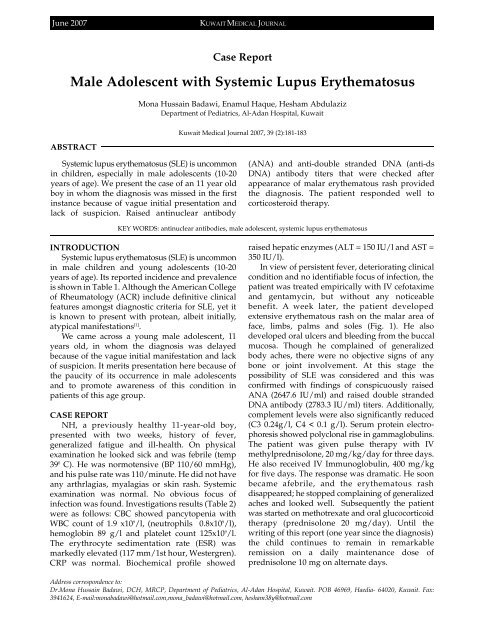Vol 39 # 2 June 2007 - Kma.org.kw
Vol 39 # 2 June 2007 - Kma.org.kw
Vol 39 # 2 June 2007 - Kma.org.kw
- No tags were found...
Create successful ePaper yourself
Turn your PDF publications into a flip-book with our unique Google optimized e-Paper software.
<strong>June</strong> <strong>2007</strong>KUWAIT MEDICAL JOURNALCase ReportMale Adolescent with Systemic Lupus ErythematosusMona Hussain Badawi, Enamul Haque, Hesham AbdulazizDepartment of Pediatrics, Al-Adan Hospital, KuwaitABSTRACTKuwait Medical Journal <strong>2007</strong>, <strong>39</strong> (2):181-183Systemic lupus erythematosus (SLE) is uncommonin children, especially in male adolescents (10-20years of age). We present the case of an 11 year oldboy in whom the diagnosis was missed in the firstinstance because of vague initial presentation andlack of suspicion. Raised antinuclear antibody(ANA) and anti-double stranded DNA ( a n t i - d sDNA) antibody titers that were checked afterappearance of malar erythematous rash providedthe diagnosis. The patient responded well tocorticosteroid therapy.KEY WORDS: antinuclear antibodies, male adolescent, systemic lupus erythematosusINTRODUCTIONSystemic lupus erythematosus (SLE) is uncommonin male children and young adolescents (10-20years of age). Its reported incidence and prevalenceis shown in Table 1. Although the American Collegeof Rheumatology (ACR) include definitive clinicalfeatures amongst diagnostic criteria for SLE, yet itis known to present with protean, albeit initially,atypical manifestations [1] .We came across a young male adolescent, 11years old, in whom the diagnosis was delayedbecause of the vague initial manifestation and lackof suspicion. It merits presentation here because ofthe paucity of its occurrence in male adolescentsand to promote awareness of this condition inpatients of this age group.CASE REPORTNH, a previously healthy 11 - y e a r-old boy,p resented with two weeks, history of fever,generalized fatigue and ill-health. On physicalexamination he looked sick and was febrile (temp<strong>39</strong> 0 C). He was normotensive (BP 110/60 mmHg),and his pulse rate was 110/minute. He did not haveany arthrlagias, myalagias or skin rash. Systemicexamination was normal. No obvious focus ofinfection was found. Investigations results (Table 2)were as follows: CBC showed pancytopenia withWBC count of 1.9 x10 9 /l, (neutrophils 0.8x10 9 /l),hemoglobin 89 g/l and platelet count 125x10 9 /l.The erythrocyte sedimentation rate (ESR) wasmarkedly elevated (117 mm/1st hour, Westergren).C R P was normal. Biochemical profile showedraised hepatic enzymes (ALT = 150 IU/l and AST =350 IU/l).In view of persistent fever, deteriorating clinicalcondition and no identifiable focus of infection, thepatient was treated empirically with IV cefotaximeand gentamycin, but without any noticeablebenefit. A week later, the patient developedextensive erythematous rash on the malar area offace, limbs, palms and soles (Fig. 1). He alsodeveloped oral ulcers and bleeding from the buccalmucosa. Though he complained of generalizedbody aches, there were no objective signs of anybone or joint involvement. At this stage thepossibility of SLE was considered and this wasconfirmed with findings of conspicuously raisedANA (2647.6 IU/ml) and raised double strandedDNA antibody (2783.3 IU/ml) titers. Additionally,complement levels were also significantly reduced(C3 0.24g/l, C4 < 0.1 g/l). Serum protein electroph o resis showed polyclonal rise in gammaglobulins.The patient was given pulse therapy with IVmethylprednisolone, 20 mg/kg/day for three days.He also received IV Immunoglobulin, 400 mg/kgfor five days. The response was dramatic. He soonbecame afebrile, and the erythematous rashd i s a p p e a red; he stopped complaining of generalizedaches and looked well. Subsequently the patientwas started on methotrexate and oral glucocorticoidtherapy (prednisolone 20 mg/day). Until thewriting of this report (one year since the diagnosis)the child continues to remain in re m a r k a b l eremission on a daily maintenance dose ofprednisolone 10 mg on alternate days.Address correspondence to:Dr.Mona Hussain Badawi, DCH, MRCP, Department of Pediatrics, Al-Adan Hospital, Kuwait. POB 46969, Haedia- 64020, Kuwait. Fax:<strong>39</strong>41624, E-mail:monabadawi@hotmail.com,mona_badawi@hotmail.com, hesham38y@hotmail.com
















